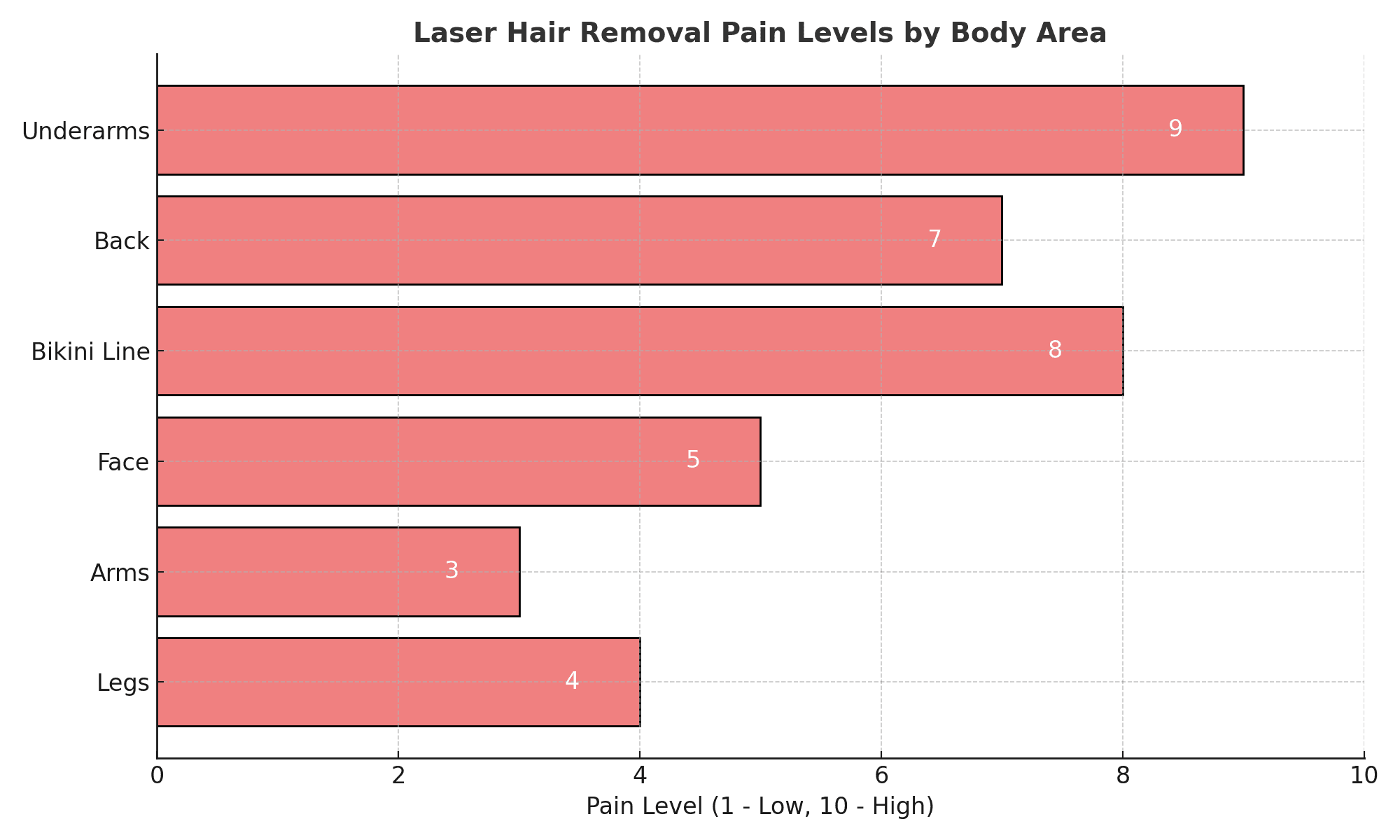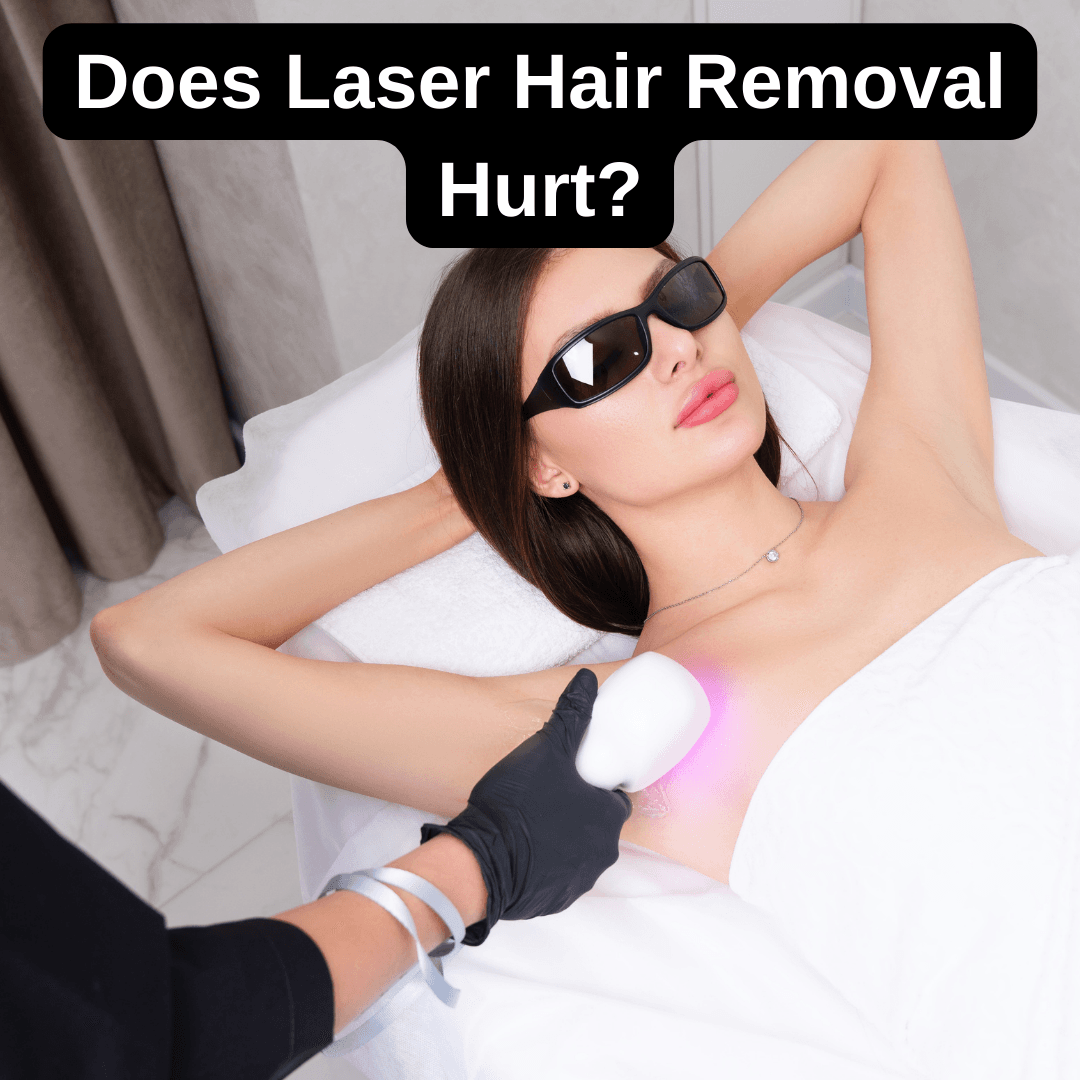Laser hair removal is one of the most popular long-term solutions for reducing unwanted hair, but one of the most common questions people ask is: Does laser hair removal hurt? While laser treatments provide long-lasting results, the level of pain can vary based on several factors such as the treatment area, individual pain tolerance, and the type of laser used.
In this guide, we’ll explore how much laser hair removal hurts in different areas of the body, compare it to other hair removal methods, and share proven tips to minimize pain during and after the procedure.
How Painful Is Laser Hair Removal?
Laser hair removal works by targeting hair follicles with concentrated light energy, which destroys the follicle and inhibits future hair growth. While the heat generated by the laser is generally tolerable, it can feel like a rubber band snapping against your skin.
Factors That Affect Pain Levels:
- Treatment Area: Sensitive areas such as the bikini line and underarms tend to hurt more.
- Skin Type and Sensitivity: Darker skin tones may absorb more heat, increasing sensitivity.
- Hair Thickness: Coarse or thick hair may result in more discomfort due to stronger heat absorption.
- Pain Tolerance: Everyone’s pain threshold is different, making the experience vary from person to person.
- Laser Type and Technology: The type of laser used during the treatment significantly affects the pain level. Different lasers operate at varying wavelengths and intensities, which impact how the skin and hair respond to heat. Some laser technologies come with cooling mechanisms that reduce discomfort, while others may feel more intense due to their higher energy output.
Pain Levels Based on Treatment Area

Pain Levels Based on Treatment Area
The level of pain experienced during laser hair removal depends greatly on the treatment area. Sensitive areas like the bikini line, underarms, and face tend to hurt more compared to less sensitive areas such as the arms and legs. The skin in these areas is thinner and has a higher concentration of nerve endings, making it more prone to discomfort.
Pain Level Breakdown by Area:
- Bikini Line: Pain level is high due to thin skin and dense hair growth.
- Underarms: Comparable to the bikini line, the underarms have delicate skin that reacts more intensely to laser heat.
- Legs and Arms: Pain level is moderate, with thicker skin that can better tolerate the laser’s heat.
To reduce pain in these areas, apply numbing cream 30–45 minutes before the procedure and opt for cooling devices during treatment. If you’re considering laser hair removal in sensitive areas such as the bikini line or underarms, it’s crucial to understand the differences between various hair removal methods and how their pain levels compare. https://www.epilationworld.com/is-waxing-better-than-epilator/
Skin Type and Sensitivity’s Role in Pain Levels
Skin type and sensitivity play a significant role in determining how painful laser hair removal can be. According to the Fitzpatrick skin type scale, darker skin tones (Type IV to VI) absorb more laser heat due to higher melanin content. This increased absorption can lead to greater discomfort during the procedure.
| Fitzpatrick Skin Type | Pain Sensitivity | Likelihood of Side Effects |
| Type I-II (Fair Skin) | Low | Mild redness, irritation |
| Type III-IV (Medium Skin) | Moderate | Temporary discoloration |
| Type V-VI (Dark Skin) | High | Increased heat absorption, risk of burns |
Pain Sensitivity by Skin Type:
- Fair Skin (Type I-II): Lower pain sensitivity, but redness and irritation may still occur.
- Medium Skin (Type III-IV): Moderate pain with a higher chance of temporary discoloration.
- Dark Skin (Type V-VI): Higher pain sensitivity due to increased heat absorption, requiring specialized lasers like Nd:YAG for safer treatment.
Choosing the appropriate laser type for your skin tone can reduce discomfort and minimize side effects.
Impact of Hair Thickness on Pain Levels
The thickness and coarseness of hair can significantly affect the pain experienced during laser hair removal. Thicker and coarser hair absorbs more heat, causing stronger sensations of discomfort compared to finer hair.
| Hair Type | Heat Absorption | Pain Level |
|---|---|---|
| Coarse Hair | High | High |
| Medium Hair | Moderate | Moderate |
| Fine Hair | Low | Low |
Why Thick Hair Hurts More:
- Higher Heat Absorption: Coarse hair retains more heat, making the laser pulse feel hotter and more intense.
- Dense Hair Growth: Areas with dense hair (such as the bikini line or underarms) can cause cumulative heat, increasing discomfort.
Shaving the treatment area 24 hours before the procedure reduces surface heat absorption, making the process less painful.
How Pain Tolerance Affects Laser Hair Removal
Pain tolerance varies greatly from person to person, making the experience of laser hair removal subjective. While some people describe the sensation as a mild stinging or snapping feeling, others may perceive the same treatment as more painful.
Factors Influencing Pain Tolerance:
- Genetics: Some people naturally have a higher pain threshold.
- Menstrual Cycle: Pain sensitivity can increase during menstruation, making treatments feel more uncomfortable.
- Stress and Fatigue: High stress levels and lack of sleep can lower pain tolerance, amplifying discomfort.
Schedule your sessions during times when your body is well-rested and hydrated to minimize pain.
Managing your pain tolerance effectively can also lead to better results, especially when combined with exfoliation after laser treatment to maintain smooth skin. https://www.epilationworld.com/when-to-exfoliate-after-laser-hair-removal/
Pain Levels Based on Different Types of Lasers
Pain Levels by Laser Type
Different types of lasers are used for hair removal, and each type affects the pain level differently. The amount of discomfort experienced during the procedure is influenced by factors such as wavelength, skin type compatibility, and intensity of the laser pulses.
The most common laser types used for hair removal are:
- Diode Laser: Ideal for most skin types, particularly effective on darker hair. It offers moderate discomfort but provides deeper penetration for longer-lasting results.
- Alexandrite Laser: One of the fastest laser options, best suited for lighter skin tones. It tends to be slightly more painful due to its shorter wavelength but is highly effective on fine to medium hair.
- Nd:YAG Laser: Specifically designed for darker skin tones, Nd:YAG has a longer wavelength, making it less painful for deeper skin tones. However, it may require more sessions for optimal results.
- IPL (Intense Pulsed Light): Although technically not a laser, IPL is commonly used for hair removal. It causes mild to moderate discomfort but is less effective on thicker or darker hair.
- Ruby Laser: The oldest type of laser, used mostly for fine and lighter hair. It causes mild discomfort but is less commonly used today due to slower treatment times.
- At-Home IPL Devices: These devices provide convenience but tend to be less powerful, resulting in milder discomfort and slower results compared to professional lasers.
Comparison of Pain Levels by Laser Type
| Laser Type | Pain Level | Skin Type Compatibility | Effectiveness | Cooling Technology |
| Diode Laser | Moderate | All Skin Types (I-VI) | High | Yes (Cooling Tip) |
| Alexandrite Laser | High | Light to Medium (I-III) | Very High | Yes (Air Cooling) |
| Nd:YAG Laser | Low to Moderate | Darker Skin (IV-VI) | Moderate | Yes (Chill Tip) |
| IPL (Intense Pulsed Light) | Mild to Moderate | Fair to Medium (I-IV) | Moderate | Limited Cooling |
| Ruby Laser | Mild | Fair Skin (I-II) | Low to Moderate | No Cooling |
| At-Home IPL Devices | Mild | Fair to Medium (I-III) | Low to Moderate | Minimal Cooling |
Detailed Analysis:
- Diode Laser: Suitable for all skin types and less painful compared to Alexandrite, but discomfort may still occur on sensitive areas.
- Alexandrite Laser: Highly effective but can be more painful due to its shorter wavelength and stronger pulses.
- Nd:YAG Laser: Preferred for darker skin tones, with moderate pain levels and a safer experience.
- IPL & At-Home IPL: Causes mild to moderate discomfort but may require more sessions for optimal results. Understanding the differences between various laser types, such as diode, Alexandrite, and IPL, helps you make an informed decision about the most effective and comfortable option for your skin type. https://www.epilationworld.com/intense-pulsed-light-laser-guide/
Opt for a laser type that suits your skin tone and hair type to minimize pain and maximize results.
For more in-depth information, refer to the Laser Hair Removal Guide by Birmingham Regional Skin Laser Centre (PDF)
What Body Part Hurts the Most During Laser Hair Removal?
1. Bikini Line and Brazilian Area
The bikini line and Brazilian area are among the most sensitive areas to treat due to the thin, delicate skin and dense hair follicles. Many people describe the pain as similar to waxing but lasting longer because laser pulses take more time. If you’re considering laser hair removal for the bikini line or Brazilian area, it’s essential to understand the key differences between waxing and laser hair removal, especially regarding pain levels and long-term results. https://www.epilationworld.com/what-is-laser-waxing/
2. Underarms (Armpits)
The underarm area is another highly sensitive region. Since the skin is thinner and the hair is usually thicker, this area tends to be more painful compared to other parts of the body.
3. Upper Lip and Face
Facial areas, especially the upper lip, are sensitive due to the proximity of nerve endings. However, the pain is usually short-lived, as these areas are small and the procedure is quick.
4. Legs and Arms
Legs and arms are less sensitive than other areas, making laser hair removal more tolerable. However, the inner thighs and ankles can still feel slightly more uncomfortable.
5. Back and Chest
The back and chest are larger areas with thicker skin, making the pain moderate. However, due to the large surface area, the duration of the session may increase, leading to more prolonged discomfort.
Does Laser Hair Removal Hurt the First Time?
Yes, laser hair removal tends to hurt more during the first session. This is because the hair follicles are thicker and the skin is not yet accustomed to the heat. However, as sessions progress and hair becomes finer, the pain level typically decreases. Applying a numbing cream before the first session can significantly reduce discomfort. Many clinics use numbing agents to ease pain, especially for sensitive areas like the bikini line and underarms.
Is Laser Hair Removal More Painful Than Waxing?
When comparing laser hair removal to waxing, the pain can feel similar but with notable differences:
- Laser Hair Removal: Feels like a snapping rubber band but lasts longer due to the duration of each pulse.
- Waxing: Involves pulling hair out from the roots, which causes a quick, sharp pain but subsides immediately.
In terms of long-term results, laser hair removal causes less frequent discomfort as it gradually reduces hair growth, while waxing needs to be repeated every few weeks.
Pain Comparison of Hair Removal Methods
Comparing Pain Levels Across Hair Removal Methods
Each hair removal method comes with a different level of pain, duration, and effectiveness. Whether you’re considering laser hair removal, waxing, or epilation, understanding the pain levels and how they compare can help you choose the most suitable method.
Here’s a breakdown of pain levels and effectiveness for popular hair removal methods:
- Laser Hair Removal: Feels like a snapping rubber band. The pain is moderate and decreases with each session. Long-term results make the temporary discomfort worth it.
- Waxing: Causes intense but brief pain as the hair is pulled from the root. The pain subsides immediately after waxing but needs to be repeated frequently.
- IPL Hair Removal: Mild to moderate discomfort that feels like a warm sensation. The results take longer to appear compared to professional laser treatments.
- Electrolysis: Considered the most painful hair removal method as each follicle is targeted with an electric current. However, results are often permanent.
- Epilation: Similar to waxing, but the pain is more prolonged as epilators pull multiple hairs at once. Pain tends to decrease after repeated use.
- Shaving: Painless during the process, but razor burns or cuts can cause mild discomfort. However, results are short-term.
Comparison of Pain Levels for Hair Removal Methods
| Hair Removal Method | Pain Level | Duration of Pain | Frequency of Treatment | Effectiveness |
| Laser Hair Removal | Moderate | Short-lasting | Every 4-6 Weeks | High |
| Waxing | High | Immediate but brief | Every 3-4 Weeks | Moderate to High |
| IPL (Intense Pulsed Light) | Mild to Moderate | Short-lasting | Every 4-6 Weeks | Moderate |
| Electrolysis | Very High | Prolonged | Weekly or Bi-weekly | Permanent |
| Epilation | High | Prolonged | Every 3-4 Weeks | Moderate |
| Shaving | Painless | None | Every 2-3 Days | Low |
Detailed Analysis:
- Laser Hair Removal: Provides the best long-term results but can cause moderate discomfort depending on the treatment area.
- Waxing & Epilation: Both involve pulling hair from the root, leading to sharp but short-lived pain.
- Electrolysis: While offering permanent results, electrolysis is highly painful and time-consuming.
- Shaving: Painless and quick but needs to be done frequently as it only removes surface hair.
For long-lasting results with minimal pain, laser hair removal is the best option, while electrolysis is recommended for permanent hair reduction despite higher pain levels.
If you’re weighing the pros and cons of different hair removal methods, understanding how long each method lasts and how it impacts your skin can guide you toward the best choice. https://www.epilationworld.com/how-long-does-laser-hair-removal-last/
What Hurts More: Laser or Tattoo?
Laser hair removal and tattoos both involve some degree of pain, but the type of discomfort is different:
- Laser Hair Removal: A sharp snapping sensation from heat energy targeting hair follicles.
- Tattoo Pain: A continuous scratching or pricking feeling as the needle deposits ink into the skin.
In general, most people report that tattoo pain is more prolonged, while laser hair removal pain is sharper but shorter in duration.
Does Laser Hair Removal Hurt More If You Don’t Shave?
Yes, skipping the shaving step before your laser hair removal session can significantly increase pain and discomfort during the procedure. When the laser targets hair that hasn’t been properly shaved, it burns the hair above the skin’s surface before reaching the follicle. This additional heat not only increases pain but also makes the treatment less effective.
To ensure a smoother and more comfortable experience, it’s essential to understand why shaving beforehand is crucial and how it directly impacts pain levels during laser hair removal.
Why Skipping Shaving Makes Laser Hair Removal More Painful
- Burning of Surface Hair Increases Heat and Pain
During laser hair removal, the laser emits intense light that targets the pigment (melanin) in the hair follicle. If the hair is not shaved down to the skin, the laser burns the hair above the surface, generating excessive heat. This can cause a burning sensation and make the treatment more painful. - Increased Risk of Skin Irritation and Burns
Longer hair absorbs more heat, increasing the likelihood of skin irritation, redness, and even mild burns. When the laser targets unshaved hair, the heat builds up on the surface, which can damage the surrounding skin and lead to post-treatment discomfort. - Reduced Effectiveness of Laser Treatment
When hair is left unshaved, the laser’s energy gets dispersed along the hair shaft rather than directly reaching the follicle. This reduces the effectiveness of the treatment and may require additional sessions to achieve desired results. Shaving ensures that the laser targets the follicle directly, making the process more efficient and less painful.
How Long Before Laser Hair Removal Should You Shave?
To minimize pain and maximize the effectiveness of your treatment, it’s best to shave 12-24 hours before your laser hair removal session.
- 12 Hours Before: Shaving too close to the session may leave the skin slightly irritated, which can increase sensitivity during the treatment.
- 24 Hours Before: This allows the skin to recover and reduces the risk of redness or irritation during the laser session.
Use a clean, sharp razor and shave in the direction of hair growth to avoid cuts, nicks, and razor burn. Avoid using chemical hair removal creams, as they can leave the skin irritated and sensitive.
What Happens If You Don’t Shave Before Laser Hair Removal?
If you skip shaving before your laser hair removal appointment, the following issues may occur:
| Consequence | Impact on Treatment |
| Increased Pain | Longer hair burns above the skin, causing discomfort. |
| Risk of Skin Irritation | Heat buildup can cause redness, burns, or swelling. |
| Reduced Efficiency | The laser may not effectively reach the follicle. |
| Longer Treatment Duration | More sessions may be required for optimal results. |
Does Shaving Right Before the Session Cause Issues?
Yes, shaving immediately before your session can also lead to problems. Shaving too close to the appointment can make the skin sensitive and irritated, which increases discomfort during the procedure. Ideally, shaving 12-24 hours prior allows the skin to settle and reduces the risk of irritation.
Tips for Proper Pre-Treatment Shaving
- Use a Clean, Sharp Razor
A dull razor can cause skin irritation and ingrown hairs, leading to discomfort during laser treatment. Always use a fresh, sharp blade for a smooth shave. - Shave in the Direction of Hair Growth
To prevent razor bumps and skin irritation, shave gently in the direction of hair growth. Avoid applying too much pressure to minimize skin irritation. - Avoid Shaving Immediately Before the Session
Shaving right before your session can make your skin overly sensitive. Aim to shave 12-24 hours before your appointment to give your skin time to recover. - Skip Exfoliating Before Shaving
Avoid using exfoliating scrubs or harsh cleansers immediately before shaving, as they can make the skin more sensitive to the laser.
Is It Safe to Wax or Use Hair Removal Creams Before Laser Treatment?
No, waxing, plucking, or using depilatory creams before laser hair removal is not recommended. These methods remove the hair from the root, which prevents the laser from targeting the follicle effectively. For best results, only shave the area prior to your session.
What If You Forget to Shave Before Your Session?
If you forget to shave before your appointment:
- Reschedule the Session: Many clinics may ask you to reschedule the session to avoid discomfort and poor results.
- Shave at the Clinic: Some clinics may provide a razor for you to shave on-site, but this may not give the skin enough time to settle, leading to increased sensitivity.
Shaving Before Laser Hair Removal Is Essential
To minimize pain and ensure effective laser hair removal, shave the treatment area 12-24 hours before your session. Skipping this step can lead to increased discomfort, skin irritation, and less effective results. Proper pre-treatment shaving allows the laser to focus on the follicle, ensuring smoother, pain-free results.
Stick to your recommended pre-treatment routine to reduce discomfort and maximize long-term hair reduction results.
Why Does Laser Hair Removal Hurt So Much?
The pain associated with laser hair removal is primarily due to:
- Heat Energy: The laser’s heat is absorbed by the pigment in the hair follicle, which can cause a sharp sensation.
- Proximity to Nerves: Areas with a higher concentration of nerve endings, such as the face, underarms, and bikini line, tend to hurt more.
To minimize pain, many clinics use cooling devices or numbing creams to reduce discomfort.
How to Make Laser Hair Removal Less Painful
If you’re worried about pain during laser hair removal, there are several effective strategies to reduce discomfort:
1. Apply a Numbing Cream
Using a topical anesthetic 30-60 minutes before your appointment can reduce the sensation of heat and snapping during the session.
2. Use a Cooling Device
Modern laser systems often include cooling technology that blows cool air on the skin to numb the area during treatment.
3. Take Pain Relievers Beforehand
Taking an over-the-counter pain reliever like ibuprofen 30 minutes before your session can help alleviate discomfort. To further reduce pain during laser treatments, considering less painful alternatives like Brazilian laser hair removal can make a significant difference. https://www.epilationworld.com/brazilian-laser-hair-removal/
4. Avoid Caffeine and Alcohol
Stimulants can increase sensitivity and anxiety, making the procedure feel more painful. Avoid them at least 24 hours before your session.
5. Schedule Sessions After Your Period
If you’re prone to sensitivity, avoid scheduling treatments right before or during your period when pain tolerance is lower.
According to Canada’s Health Guidelines for Laser Hair Removal, proper cooling techniques and skin protection protocols can significantly reduce discomfort and minimize risks associated with laser treatments. Link: Laser Hair Removal – Safety Guidelines for Facility Owners and Operators (Canada.ca)
According to Saint Mary’s Hospital, applying a cool pack and using pain relief such as Ibuprofen can effectively manage discomfort after laser treatments. For detailed aftercare guidance, refer to the Care of Your Vulva Following Laser Treatment Guide by NHS.
Where Is the Most Painful Place to Get Laser Hair Removal?
The most painful areas for laser hair removal include:
- Bikini Line/Brazilian Area: Due to high sensitivity and thick hair follicles.
- Underarms: Because of the thin skin and dense hair growth.
- Upper Lip: Due to proximity to nerve endings.
In contrast, areas like the legs, arms, and stomach are generally more tolerable.
Does Laser Hair Removal Hurt More Over Time?
No, laser hair removal does not hurt more over time — in fact, it usually becomes less painful with each session. As the treatment progresses, the hair follicles weaken, and the remaining hair becomes finer and lighter. This reduction in hair thickness means that subsequent laser pulses generate less heat, leading to significantly less discomfort in later sessions.
Why Does Laser Hair Removal Get Less Painful Over Time?
- Weaker Hair Follicles:
Each laser session targets and damages the hair follicle, preventing future hair growth. As the follicles weaken, the remaining hairs become thinner and easier to treat, reducing the intensity of heat absorbed by the skin. - Less Hair Density:
After a few sessions, there’s less hair to target, which means fewer follicles absorb heat during treatment. With less hair, the laser has less work to do, making the procedure less intense and reducing the sensation of discomfort. - Reduced Heat Absorption:
Coarse and thick hair absorbs more heat, making the initial sessions more intense. Over time, finer hairs absorb less heat, resulting in milder sensations during subsequent treatments. - Lower Nerve Sensitivity:
As the skin becomes accustomed to the laser’s heat, nerve endings in the treated areas become less sensitive. This desensitization leads to a gradual decrease in pain perception after each session.
Pain Reduction Timeline by Session
| Session Number | Pain Level (Compared to Initial Session) | Reason for Reduced Pain |
| 1st Session | Highest Pain Level | Thick, coarse hair absorbs more heat |
| 2nd – 3rd Session | Moderate Pain Level | Follicles begin to weaken |
| 4th – 6th Session | Mild to Moderate Pain Level | Fewer active hair follicles |
| 7th+ Session | Minimal Discomfort | Remaining hairs become finer and lighter |
Ready for Smooth, Hair-Free Skin? Laser Hair Removal Delivers Lasting Results
Laser hair removal offers more than just a break from constant shaving and waxing. With fewer ingrown hairs, smoother skin, and long-lasting results, this treatment is a game-changer for anyone seeking a low-maintenance hair removal solution. While the initial discomfort may be a concern, advancements in technology and pain management techniques make the experience more comfortable than ever.
By choosing the right laser type, preparing properly, and following aftercare guidelines, you can minimize pain and maximize results. Whether you’re considering laser hair removal for your legs, face, or sensitive areas like the bikini line, consistent sessions ensure long-term success.
Curious about how long the results last? Check out our in-depth guide:
How Long Does Laser Hair Removal Last?

Meet the Epilation World Expert Team
Our team consists of certified professionals with over 17 years of experience in laser hair removal, skincare, and personal care. With advanced training in diode laser, IPL, waxing, and skin health, we combine clinical precision with real-world expertise to deliver reliable, evidence-based guidance.
Every article is carefully created and reviewed by our experts to ensure safety, clarity, and scientific accuracy. Our work has helped thousands choose safe, effective hair removal solutions tailored to their unique needs.
Trusted expertise. Real results. That’s our promise.





